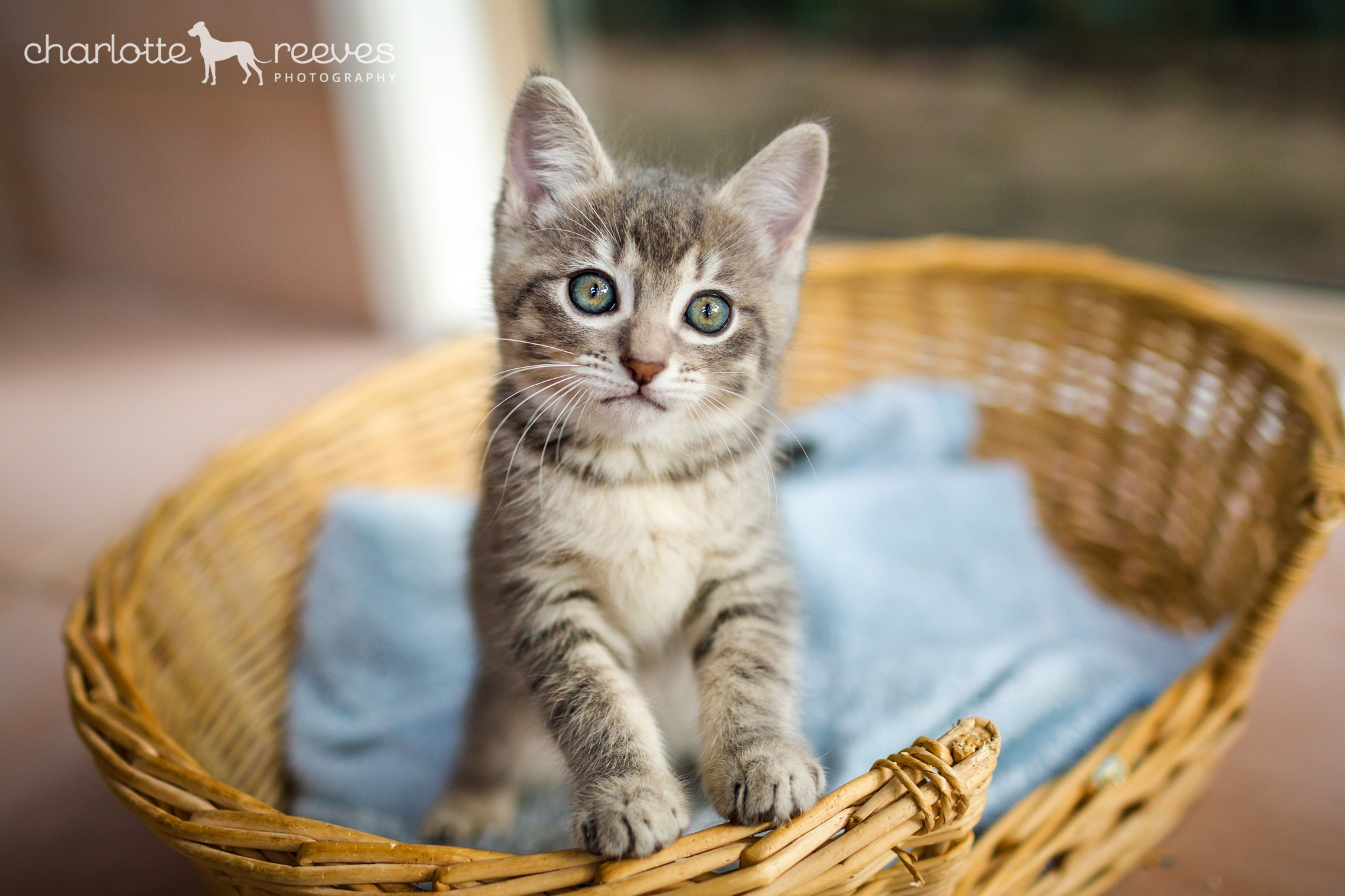8 Tips for Capturing Creative Cat Photos
Mar 31, 2016
By Charlotte Reeves
Photographing cats and kittens is a whole different game than working with dogs. In some ways, they are easier, but in others, they are so much more challenging! Discover my best tips for successfully capturing amazing shots of cats, working with their individual traits to capture beautiful images focusing on their inherent beauty and unique personalities.
1. Basket case
Cats and especially kittens love to play in and around objects, especially when they have a rough or scratchy texture. I purchased some square baskets cheaply for this purpose and often take them along to adoptable cat shoots. It gives them something to crawl into - cats love boxes! - and something to play with, in and around. They're a great icebreaker and nice looking enough to work as a prop when the background is fairly plain.

Canon EOS 1D X, Canon 35mm f/1.4L, ISO 1000, 1/400 sec, f2
2. Small pupils
Just like humans, when cats look towards bright light, their pupils constrict, which makes their eyes appear bigger, brighter and more colourful.
When photographing cats indoors, face them towards a light source such as a window, to get as much light on their faces as possible and avoid the dreaded "black eyes" look!

Canon EOS 5D Mark II, Canon EOS 50mm f/1.4, ISO 500, 1/320 sec, f/2
3. Hide and seek
We all know the saying - "curiosity killed the cat" - and while that's not our aim, it's a good reminder that cats are innately inquisitive creatures. They are natural born hunters, and are generally highly interested in sudden small movements and things disappearing and reappearing in their field of view.
Because the most expressive photos of cats are those where the cat is looking directly at the camera, you can use this natural trait to your advantage when photographing them.
Play on their natural curiosity - a game of hide and seek can really get them interested in you!

Canon EOS 1D X, Canon EOS 24-70mm f/2.8L @ 45mm, ISO 640, 1/500 sec, f/2.8
4. Use toys
You can also use the natural curiosity of cats to get their attention with new and interesting toys - feathers, bits of string, mouse-shaped toys - anything to get them intrigued!
Enlisting the cat's owner to help is a good plan, as they can flick the toy around to get the cat looking towards your lens. It's possible to do it solo as well, it just takes a bit more co-ordination! 😆

Canon EOS 1D X, Canon EOS 24-70mm f/2.8L @ 24mm, ISO 640, 1/500 sec, f/2.8
5. Prepare for the unexpected
Keeping your shutter speed high at all times is invaluable when the unexpected happens! I was shooting some candid portrait shots of my new kitten on my deck when she came racing towards me sideways - if I hadn’t had a fast shutter speed already set I would have missed getting a sharp shot like this.

Canon EOS 1D X, Canon EOS 100mm f/2.8L Macro IS, ISO 640, 1/1250 sec, f/2.8
6. Declutter
Not everyone lives in a show home! When photographing cats indoors, do a quick clean-up of the room you're shooting in. Often there will be clutter in the background that can easily be removed before you start shooting. Much easier than trying to edit it out later!

Canon EOS 1D X, Canon EF 35mm f/1.4L, ISO 320, 1/800 sec, f/1.8
7. Indoor reflectors
When shooting cats indoors I usually try and face them towards the light source such as a big window or doorway. Look out for natural reflectors in the room, however - in this case, there was a huge mirror facing the window that reflected light back onto the shaded side of this gorgeous old kitty. This enabled me to use the window light as backlight which helped separate her from the background by providing a lovely rim light around the edge of her fur.

Canon EOS 1D X, Canon EF 100mm f/2.8L Macro IS, ISO 1250, 1/200 sec, f/2.8
8. Use a fast prime lens
My favourite lens for shooting indoors with natural light is the 35mm f/1.4. It’s wide enough so you can shoot while up close to your subject - good for cats and kittens where you’re also interacting with them as you’re shooting.
It’s a very fast lens, which means you can use a faster shutter speed as the aperture is so much bigger which lets more light onto the sensor. This helps reduce dark or blurry photos.

Canon EOS 1D X, Canon EF 35mm f/1.4L, ISO 800, 1/800 sec, f/2
Join our mailing list!
Want to improve your pet photography with free tips and expert advice?
Join our mailing list and get a guided tour of what we have to offer, along with our weekly newsletter packed with practical pet photography insights.
📩 Sign up now and start learning with us!
We hate SPAM. We will never sell your information, for any reason.

